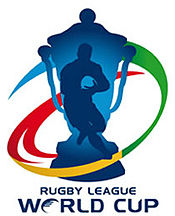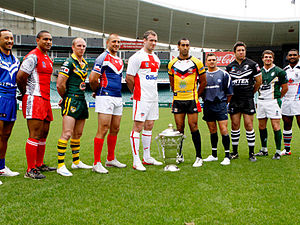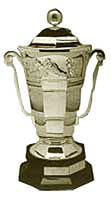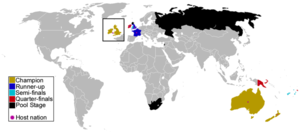- Rugby League World Cup
-
Not to be confused with Rugby Union World Cup.
Rugby League World Cup  Current season or competition:
Current season or competition:
2013
Sport Rugby league football Instituted 1954 Number of teams 10 (Finals) Region International (RLIF) Holders  New Zealand (2008)
New Zealand (2008)Website www.rlif.com/world_cup The Rugby League World Cup is an international rugby league competition contested by members of the Rugby League International Federation (RLIF). It has been held nearly once every 4 years on average since its inaugural tournament in France in 1954. This was the first World Cup of either rugby code and the first competition to be officially known as the "Rugby World Cup".[1][2]
The most recent tournament was contested in Australia in 2008 and was won by New Zealand for the first time. In the thirteen tournaments held to date, three nations have won the competition (Australia nine times, Great Britain three times and New Zealand once) out of the seventeen total teams who haven taken part. Australia, France and New Zealand are the only teams to have played in all tournaments, with Great Britain being split into England, Wales, Scotland and Ireland since 1995. The next competition in 2013 will be in the United Kingdom, and will form part of the UK's 'Golden Decade of Sport'[3]
Since 2000, the RLIF has also organised World Cups for Women, Students and other categories.
Contents
History
The Rugby League World Cup was an initiative of the French, who had been campaigning for a Rugby League World Cup since 1935. The idea was further pursued in 1951 in post-war France, with the pioneer of the concept being Paul Barrière, the President of the French Rugby League. In January 1952 the idea gained momentum as Rugby Football League secretary Bill Fallowfield persuaded the Rugby League Council to support the concept.[4] At a meeting held in Blackpool, England, November 1953, the International Board accepted Paul Barrière’s proposal that France should be the nation to host the first World Cup, the inaugural "World Cup" of either rugby code.[4] In addition to the hosts, the tournament was intended to feature teams from Britain, Australia, New Zealand and America.[5] The first World Cup was held the following year, with all invited teams playing except for America, and Great Britain defeated France in Paris on 13 November to claim the title.
 Captain of the winning British team, Dave Valentine presented with the trophy at the inaugral world cup in 1954
Captain of the winning British team, Dave Valentine presented with the trophy at the inaugral world cup in 1954
The World Cup was initially contested by the four Test nations: Australia, Great Britain, France and New Zealand. The teams played each other in a league format. After a final was played between the top two teams in 1954, it was decided that the team that finished first in the league standings would be declared the winner for the second World Cup in Australia in 1957. Australia proved victorious on their home ground.
After the successful 1960 competition, in which Great Britain won the title for the second time, there would be no further World Cup for eight years. The competition had been scheduled to be held in France in 1965, this time with the inclusion of the South African team.[6] However after an unsuccessful tour of Australia, the French withdrew. The tournament was next held in 1968, and followed a two-year cycle until the mid-1970s. The 1972 World Cup final ended in a 10-all draw, and the title was awarded to Great Britain by virtue of their superior record in the qualifiers.
In 1975 the competition underwent its most radical overhaul to date. It was decided to play matches on a home and away basis around the world, instead of in any one host nation. Furthermore, the Great Britain team was split into England and Wales. Australia won that tournament, and in 1977 it was decided that Great Britain should once more compete as a single entity. Although the final between Australia and Great Britain was a closely fought affair, public interest in the tournament waned due to the continuing tinkering with the format, and it would not be held again until the mid-1980s.
From 1985 to 1988, each nation played each other a number of times on a home and away basis. At the end of that period Australia met New Zealand at Eden Park. The match was a physical encounter, and Australian captain Wally Lewis played part of the match with a broken arm. The Kangaroos won the competition 25-12. This format was repeated from 1989–1992, and Australia won again, defeating Great Britain 10-6 at Wembley Stadium in front of 72,000 people. This crowd remains a Rugby League World Cup record.
 Captains of the ten teams that contested the 2008 World Cup.
Captains of the ten teams that contested the 2008 World Cup.
In 1995 the competition was once again restructured, and the largest number of teams to date (10) entered. New teams competing included Fiji, Tonga, Samoa and South Africa. Due to the Super League war, players aligned with the rebel competition were not selected by the ARL to represent the Kangaroos. This meant the absence of many star players from the Australian team's line-up. The tournament, which was also held to celebrate the centenary of the sport in England, was highly successful with over 250,000 people attending the group stages and over 66,000 people attending the final to see Australia defeat England 16-8.
Following the Super League war, the subsequent re-structuring of rugby league's international governing bodies meant that the proposed 1998 World Cup was postponed.[7]
The 2000 World Cup expanded the field further, with 16 teams entering. Blown out score lines meant that this tournament was not as successful as the previous one. In the same year, the first Women's Rugby League World Cup was held.
In 2008 Australia hosted the tournament again and New Zealand became only the third team to win the World Cup.
Trophy
Several trophies have been presented to the winners of the Rugby League World Cup.
Original and current trophy
The original World Cup trophy, which is the one in use, was commissioned by the French Fédération Française de Rugby à XIII president Paul Barrière at a cost of eight million francs and then donated to the International Rugby League Board to be used for the inaugural competition in 1954.[8] This trophy would be used and presented to the winning nation for the next four tournaments. The trophy is currently housed at the New Zealand Rugby League Museum until 2013, which is located at Rugby League House, 7 Beasley Avenue, Penrose, Auckland, New Zealand.[9]
Theft of original World Cup trophy and recovery
While competing in the 1970 tournament, the reigning champions, Australia, put the trophy on display in the Midland Hotel, Bradford.[10] The trophy was stolen six days before the final, on the night of Sunday, November 1, 1970 and remained unseen for the next 20 years.[10][11] Before its theft the trophy was last held aloft by Johnny Raper after Australia's 20-2 win over France at the Sydney Cricket Ground on 10 June 1968 to claim the fourth World Cup title.
However, the trophy was not the one which was due to be competed for and presented in the World Cup Final the following Saturday at Headingley Stadium. With the commencement of sponsorship in the game, administrators had decided to play for a new sponsored trophy, whilst keeping the original safe and on display at the hotel in a symbolic capacity only.[12]
Nothing was known of the trophy's whereabouts for the next 20 years. In 1990, a father-of-four named Stephen Uttley discovered the trophy amongst rubbish dumped in a ditch near the Bradford and Bingley Rugby Club, in Bingley.[10] He was at the time unaware of the significance of his find. Uttley made enquiries at local rugby clubs in Bradford, including Bradford Northern, without success. He turned the trophy in to the police but it was returned to him 28 days later after no-one had come forward to claim it. He tried contacting Yorkshire Television's Calendar programme about it but could not interest them in the story. There were plans that the trophy might be turned into a body building trophy at Uttley's local gym.[13] Uttley was still determined to find the cup's owner, and contacted the local Telegraph & Argus newspaper who ran an article on it. The trophy was identified from this by rugby league historian Trevor Delaney, who notified the police, the paper and the Rugby Football League (RFL) of the find. Delaney and Uttley were concerned for the safety of the trophy, which was being kept at Uttley's council house, believing it to be increasingly vulnerable due to the media attention placed on it. They were anxious it should be turned over to the authorities before it was stolen again.[12]
On Friday, 1 June 1990, the trophy was presented to Roger Millward representing the RFL outside the White Rose Health club in Bradford at 10:30am. The cup was then taken to the RFL's headquarters in Leeds.[14] Speaking on its return, RFL spokesman David Howes commented, "It is like the return of the Holy Grail.[10] No-one knows what its value is, but in rugby league terms it is priceless".[10] The RFL were pleased to offer a reward to Mr Uttley for the trophy's welcome return, offering "anything except a place in the team" Howes joked.[10] Mr Uttley asked only for some tickets to matches.[10]
The original World Cup trophy was brought back into use for the 2000 World Cup minus the cockerel that had adorned it initially. It was presented to the victorious Australian team. The trophy featured again during the 2008 World Cup, when it was used prominently as the basis for the competition logo. It is likely this trophy will be retained for the 2013 competition and thereafter.
Past trophies
While no trophy could be presented in 1970 due to the original's disappearance a few days before the final, several other trophies were used from 1972 until 1995.
Format
The Rugby League World Cup has followed a varied range of formats throughout its history as the number of teams participating has increased.
1954 to 1972 and 1977 format
From 1954 until 1972 the World Cup competition had only featured four teams in Australia, Britain, France and New Zealand; because of this a current format of World Cup would have been impractical. Instead the RLIF adopted a league format with a points system, with all four teams playing each other. The two teams with the most points after the designated matches played off in a final to decide the champion. This style was re-introduced for the 1977 tournament.
1975 to 1992 format
For the 1975 tournament, a new format was introduced where no single country would host the world cup; rather each country playing in the tournament would host all home fixtures in their own country and play away in the country of their opposition. There was no final, with the team at the top of the points table being declared winner. This style of tournament saw a further three countries enter the cup under the league format; England, Papua New Guinea and Wales. The home and away style was dropped for 1977, but was used for a further two world cups in the eighties, (1985-88 and 1989-92) which saw the length of the series stretched from 8 months in 1975 to 3 years.
Qualification since 1995
Since the 1995 tournament the majority of teams have had to qualify for the World Cup tournament. There are 3 qualifying groups, European, Oceania and Pacific Islands and Atlantic. Teams start off playing in their respective group and attempt to qualify by. The remaining teams who are unsuccessful at qualifying in this fashion attempt to gain entry via the repêchage rounds of the World Cup qualifiers. groups of teams have been placed in a qualifying pool followed by a finals system. The top teams in each pool qualify into the next round.
In 1995, there were 10 teams split into one group of four, and two groups of three. The top two teams progressed in the group of four and the top team progressed from each of the groups of three into the semi-finals. The winners of the semi-finals progressed to the final. Moldova, Russia, USA, Cook Islands, Morocco, Ireland and Scotland competed in a parallel Emerging Nations World Cup.[15]
In 2000, sixteen teams were split into four groups of four. The top two teams from each group progressed to the knockout quarter finals. The winners of the quarter finals played in the semi-final and the winners of the semi-finals progressed to the final. The parallel Emerging Nations tournament was repeated with debuts from teams from Japan, Canada and Italy
The 2008 tournament followed a similar format to the 1995 competition. The 10 teams were split into one group of four, and two groups of three. Three teams progressed into the semi-finals in the group of four and the winners of the two groups of three went to a playoff for a position in the semi-final. The winners of the semi-finals progressed to the final. For the 2008 tournament five teams were granted automatic entry into the cup and therefore did not have to gain admission through the qualifying stages. These five teams included England and the original four that entered the World Cup between 1954 and 1992; Australia, France, Papua New Guinea and New Zealand.
The 2013 edition sees an expansion to 14 teams, comprising two groups of four and two groups of three. As in 2008, due to the groups of four consisting of more higher seeded sides, three nations from each will qualify for the quarter-finals where they will be joined by the two winners of the groups of three.
The host and format of the 2017 World Cup has not yet been decided. At the 2010 Rugby League International Federation executive meeting the New Zealand Rugby League made an early submission to co-host the 2017 tournament with Australia.[16]
Results
World Cup summaries
Successful national teams
Australia, France and New Zealand are the only nations who have appeared at every Rugby League World Cup from 1954 to 2008. England has also have been at all, but participated under the banner of Great Britain in the majority of the earlier tournaments. Wales, including as Great Britain, has competed in all but the 2008 tournament.
Up to and including the 2008 tournament only Australia, New Zealand and Great Britain have been crowned World Cup champions with Australia easily the most successful winning nine of the thirteen tournaments but many other nations have performed well in the tournament since its inception over fifty years ago. France have been runners-up on two occasions including the inaugural cup where they were captained by Puig Aubert, New Zealand and England have also finished runners-up on two occasions.
Ireland and Wales have twice made it past the qualifying pool stages. Other nations to have proceeded to the knock-out stages in one tournament are Papua New Guinea, Fiji and Samoa.
The United States and Italy will compete in their first World Cup in 2013 after successfully qualifying in 2011.
The following list, are all the teams that have competed in a World Cup tournament since its inception; the number of times they have appeared; their most recent appearance; consecutive appearances and their highest result:
Nation Number of appearances First appearance Most recent appearance Most consecutive cups Best result  Australia
Australia13 1954 2008 13 Champion, 1957; 1968; 1970; 1975; 1977; 1988; 1992; 1995; 2000  Great Britain
Great Britain9 1954 1992 6 Champion, 1954; 1960; 1972  New Zealand
New Zealand13 1954 2008 13 Champion, 2008  France
France13 1954 2008 13 Runner-up, 1954; 1968;  England
England4 1975 2008 3 Runner-up, 1975; 1995  Wales
Wales3 1975 2008 2 Semi-finalist, 1995; 2000  Fiji
Fiji3 1995 2008 3 Semi-finalist, 2008  Ireland
Ireland2 2000 2008 2 Quarter-finalist, 2000, 2008  Papua New Guinea
Papua New Guinea5 1988 2008 5 Quarter-finalist, 2000  Samoa
Samoa3 1995 2008 3 Quarter-finalist, 2000  Tonga
Tonga3 1995 2008 3 Two wins, 2008  Scotland
Scotland2 2000 2008 2 One win, 2008  Aotearoa Māori
Aotearoa Māori1 2000 2000 1 One win, 2000  South Africa
South Africa2 1995 2000 2 No games won  Cook Islands
Cook Islands1 2000 2000 1 No games won  Lebanon
Lebanon1 2000 2000 1 No games won  Russia
Russia1 2000 2000 1 No games won Awards
The top point scorer for each tournament is recognised with an official award by the Rugby League International Federation. In the début tournament the highest point scorer was the France national rugby league team's Puig Aubert.
Records and statistics
Overall Championships
Championships Nation 9  Australia
Australia3  Great Britain
Great Britain1  New Zealand
New ZealandOverall top pointscorers
Points Scorers 112  Mick Cronin
Mick Cronin108  Michael O'Connor
Michael O'Connor94  /
/ George Fairbairn
George FairbairnMost appearances
Appearances Individual 25  Kurt Sorenson
Kurt Sorenson17  /
/ John Atkinson;
John Atkinson;  Bob Fulton
Bob Fulton15  Mal Meninga;
Mal Meninga;  Michael O'Connor
Michael O'ConnorWorld Cup winning captains and coaches
Year Captain Coach Team 1954 Dave Valentine G Shaw 
1957 Dick Poole Dick Poole 
1960 Eric Ashton William Fallowfield 
1968 Johnny Raper Harry Bath 
1970 Ron Coote Harry Bath 
1972 Clive Sullivan Jim Challinor 
1975 Arthur Beetson Graeme Langlands 
1977 Arthur Beetson Terry Fearnley 
1988 Wally Lewis Don Furner 
1992 Mal Meninga Bob Fulton 
1995 Brad Fittler Bob Fulton 
2000 Brad Fittler Chris Anderson 
2008 Nathan Cayless Stephen Kearney 
See also
- Rugby League International Federation
- RLIF World Rankings
- List of International Rugby League Teams
- Emerging Nations Tournament
- European Cup
- Mediterranean Cup
- Pacific Cup
- Tri-Nations
- Tertiary Student Rugby League World Cup
- Rugby League World Cup Records
External links
- Official Rugby League World Cup Website
- Rugby League International Federation
- BBC website, History (1954–2000) retrieved 2 May 2006
- "RLIF Meeting", 2008 World Cup European Rugby League Federation, retrieved May 8, 2006
- "Kiwi hangover after the hype", 2013 World Cup retrieved 8 May 2006
- Rugby League World Cup at napit.co.uk
References
Inline
- ^ Folkard, 2003: 337
- ^ SPARC, 2009: 28
- ^ "RLWC2013 official website". RLWC2013 venues. Rugby League International Federation Ltd. http://www.rlwc2013.com/venues. Retrieved 3 September 2011.
- ^ a b Waddingham, Steve (2008-06-14). "Why this trophy for winning the rugby league World Cup?". Brisbane: The Courier-Mail. Archived from the original on 2010-01-10. http://www.webcitation.org/5mgYPlubA. Retrieved 10 January 2010.
- ^ AAP (1953-01-19). "World Cup Suggestion". The Sydney Morning Herald (Australia): pp. 7. http://news.google.com/newspapers?id=CbAUAAAAIBAJ&sjid=froDAAAAIBAJ&pg=2635,2047144. Retrieved 2009-12-25.
- ^ AAP; Reuter (1962-08-15). "League Cup Year Fixed". The Sydney Morning Herald (Auckland): pp. 18. http://news.google.com/newspapers?id=E1MVAAAAIBAJ&sjid=u-UDAAAAIBAJ&pg=3222,4068871. Retrieved 2009-10-06.[dead link]
- ^ John Coffey, Bernie Wood (2008). 100 years: Māori rugby league, 1908-2008. Huia Publishers. pp. 302. ISBN 1869693310, 9781869693312. http://books.google.co.uk/books?id=nklWo8vw-iIC&printsec=frontcover.
- ^ RLIF. "Past Winners: 1954". Rugby League International Federation. http://www.rlwc08.com/about/pastwinners.aspx?article=1954. Retrieved 2008-10-25.
- ^ "The Rugby League Museum". New Zealand Rugby League, Tuesday, August 17, 2010. http://www.nzrl.co.nz/museum.aspx. Retrieved 14 September 2011.
- ^ a b c d e f g "Trophy back home - after 20 years". The Sun-Herald (Sydney: Fairfax Digital): pp. 90. 1990-06-02. Archived from the original on 2010-01-10. http://www.webcitation.org/5mgYtEbHa. Retrieved 2009-10-07.
- ^ Harlow, Phil (2008-10-21). "Rugby League World Cup history". BBC Sport. http://news.bbc.co.uk/sport1/hi/rugby_league/7646887.stm. Retrieved 10 January 2010.
- ^ a b "League Freak- Rugby League History - The Rugby League World Cup". The First Rugby World Cup,January 25, 2007 02:37:29. http://www.leaguefreak.com/print.php?type=A&item_id=55. Retrieved 1 September 2011.
- ^ Laybourn, Ian. "World Cup History". Sporting Life, rugby league news. 365 Media Group Ltd. http://www.sportinglife.com/rugbyleague/news/story_get.cgi?STORY_NAME=rleague/08/10/03/RUGBYL_World_Cup_History.html. Retrieved 2 September 2011.
- ^ "Rugby League World Cup". RLWC Trophy. Rugby League International Federation Ltd. http://www.rlif.com/history/the-trophy.
- ^ "Rugby League World Cup History". Rugby League World Cup 2013 offical website. Rugby League International Federation Ltd. http://www.rlwc2013.com/history. Retrieved 2 September 2011.
- ^ Kilgallon, Steve (1 August 2010). "NZ prepares bid to co-host 2017 World Cup". The Sunday Star-Times. http://www.stuff.co.nz/sport/league/3979019/NZ-prepares-bid-to-co-host-2017-World-Cup. Retrieved 15 September 2011.
- ^ a b c d e f McCann, 2006: 83
- ^ http://www.rleague.com/db/article.php?id=35450
General
- Folkard, Claire (2003). Guinness World Records 2003. Bantam Books. ISBN 055358636X, 9780553586367. http://books.google.com/books?id=xT_DXO6kg9MC&source=gbs_navlinks_s.
- McCann, Liam (2006). Rugby: Facts, Figures and Fun. AAPPL. ISBN 1904332544, 9781904332541. http://books.google.com/books?id=CDk7MpyX4jUC.
- Independent Review Committee (February 2009). "Rugby League - Contributing to New Zealand's Future". New Zealand: SPARC. Archived from the original on 2010-10-01. http://www.webcitation.org/5tAHkKqA2. Retrieved 13 December 2009.
- Rleague.com (February 23, 2010). "20 TEAMS TO VIE FOR WORLD CUP GLORY IN 2013". [International Rugby League]. http://www.rleague.com/db/article.php?id=35450.
Rugby League World Cup Tournaments Qualifying Squads World cups between national teams and representatives Team American football (men - women) · Association football (men - men's club - women) · Athletics · Australian rules football · Badminton (men - women - mixed) · Bandy · Baseball (men - women) · Basketball (men - women - wheelchair) · Beach soccer · Boxing · Bull riding · Cricket (men - women - indoor) · Field hockey (men - women) · Fistball (men - women) · Futsal (FIFA men - AMF men - AMF women) · Golf (men - women) · Handball (men - women) · Ice hockey · Korfball · Lacrosse (men - women) · Nine-ball · Pitch and putt · Racquetball · Rowing · Rugby league (men - women) · Rugby union (men - women - sevens) · Snooker · Softball · Tennis (men - women - mixed) · Touch football · Twenty20 cricket · Volleyball · Water polo (men - women)Mixed Biathlon · Diving · Luge · Paralympic (summer - winter) · Road bicycle racing (men - women) · Speedway motorcycle · Track cyclingIndividual Bobsleigh · Canoe slalom · Cyclo-cross · Mountain bike racing · Orienteering · Show jumping · Skeleton · Speed skating (normal - short-track) · Skiing (alpine - cross-country - Nordic combined) · Ski jumping · Ski orienteering · Snowboard · Sport shooting · Swimming · Ten-pin bowling · TriathlonCategories:- Rugby League World Cup
- Rugby league international tournaments
- Rugby league
- World championships
Wikimedia Foundation. 2010.


